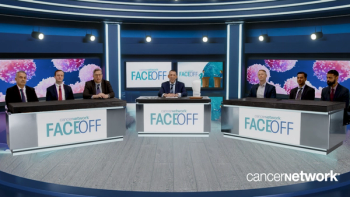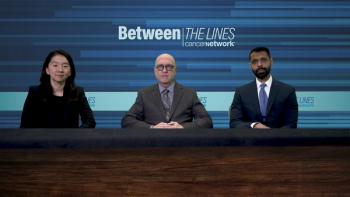Articles by Raji Shameem, MD

Patient Case Presentation: Patient on ESA for First-Line Therapy and Not Receiving a Marked Response—What Do You Do Next, and Why?
ByThomas W. LeBlanc, MD, MA,Guru Subramanian Guru Murthy, MD, MS, Raji Shameem, MD,Daniel DeAngelo, MD, PhD,Rafael Madero-Marroquin, MD,Mikkael A. Sekeres, MD, MS Panelists discuss management strategies for a patient with low-risk myelodysplastic syndrome with erythropoiesis-stimulating agent (ESA) failure, weighing options between initiating luspatercept or escalating ESA dosage while emphasizing the need for thorough evaluation of reversible causes before advancing therapy.

Patient Case Presentation: Patient Is RBC Transfusion Eligible—Would You Proceed to Transfusion or Initiate Long-Term Anemia Treatment Strategies?
ByThomas W. LeBlanc, MD, MA,Guru Subramanian Guru Murthy, MD, MS, Raji Shameem, MD,Daniel DeAngelo, MD, PhD,Rafael Madero-Marroquin, MD,Mikkael A. Sekeres, MD, MS Panelists discuss a complex case of lower-risk myelodysplastic syndrome in a patient with rheumatoid arthritis, debating immediate transfusion for symptom relief vs thorough evaluation and targeted long-term anemia management to balance comorbidities and optimize outcomes.

Debate: Sequencing Therapies for LR-MDS: ESA First vs Luspatercept First
ByThomas W. LeBlanc, MD, MA,Guru Subramanian Guru Murthy, MD, MS, Raji Shameem, MD,Daniel DeAngelo, MD, PhD,Rafael Madero-Marroquin, MD,Mikkael A. Sekeres, MD, MS Panelists discuss the sequencing of therapies in lower-risk myelodysplastic syndromes, debating whether to initiate treatment with erythropoiesis-stimulating agents due to cost and patient variability or with luspatercept for its superior efficacy and potential disease-modifying effects, while highlighting ongoing trials exploring combined or sequential strategies.

Debate: Inflection Point for LR-MDS Therapy: Serum EPO >200 U/L vs Serum EPO >500 U/L
ByThomas W. LeBlanc, MD, MA,Guru Subramanian Guru Murthy, MD, MS, Raji Shameem, MD,Daniel DeAngelo, MD, PhD,Rafael Madero-Marroquin, MD,Mikkael A. Sekeres, MD, MS Panelists discuss treatment strategies for lower-risk myelodysplastic syndromes guided by serum erythropoietin (EPO) levels, weighing the reduced efficacy of erythropoiesis-stimulating agents at higher EPO levels against newer therapies’ benefits and challenges, and emphasizing personalized sequencing based on patient and disease characteristics.

Debate: Optimal Initiation of ESAs, Luspatercept, and Imetelstat: Pretransfusion vs Posttransfusion
ByThomas W. LeBlanc, MD, MA,Guru Subramanian Guru Murthy, MD, MS, Raji Shameem, MD,Daniel DeAngelo, MD, PhD,Rafael Madero-Marroquin, MD,Mikkael A. Sekeres, MD, MS Panelists discuss the debate on optimal timing for initiating therapies in lower-risk myelodysplastic syndromes, balancing early intervention to improve quality of life and prevent complications against a conservative approach favoring treatment initiation upon transfusion dependency or symptom onset.

IMerge Trial
ByThomas W. LeBlanc, MD, MA,Guru Subramanian Guru Murthy, MD, MS, Raji Shameem, MD,Daniel DeAngelo, MD, PhD,Rafael Madero-Marroquin, MD,Mikkael A. Sekeres, MD, MS Panelists discuss findings from the IMerge phase 3 trial of imetelstat in lower-risk myelodysplastic syndromes, emphasizing its impact on transfusion independence and fatigue improvement, and advocating for a sequential, patient-centered treatment approach to enhance quality of life and long-term outcomes.

COMMANDS and ELEMENT-MDS Trials: Long-Term Analysis, Survival, Duration of Response, and Hemoglobin Levels
ByThomas W. LeBlanc, MD, MA,Guru Subramanian Guru Murthy, MD, MS, Raji Shameem, MD,Daniel DeAngelo, MD, PhD,Rafael Madero-Marroquin, MD,Mikkael A. Sekeres, MD, MS Panelists discuss long-term results from a phase 3 trial comparing luspatercept and epoetin alfa in lower-risk MDS, highlighting luspatercept’s superior efficacy in achieving sustained transfusion independence and the need for further research on earlier intervention strategies.

Early vs Late Onset of ESA in LR-MDS: Results From Phase 3 EPO-PRETAR Trial
ByThomas W. LeBlanc, MD, MA,Guru Subramanian Guru Murthy, MD, MS, Raji Shameem, MD,Daniel DeAngelo, MD, PhD,Rafael Madero-Marroquin, MD,Mikkael A. Sekeres, MD, MS Panelists discuss the results of the phase 3 EPO-PRETAR trial in a dynamic, debate-style forum on lower-risk myelodysplastic syndromes, weighing the benefits of early vs late erythropoiesis-stimulating agent initiation while highlighting the need for more patient-centered outcome measures.

Panelists discuss how future analyses in advanced gastric cancer should assess long-term survival, real-world outcomes, biomarkers for response, resistance mechanisms, and patient selection for nivolumab plus chemotherapy. Evaluating these factors will optimize treatment strategies and confirm its role across diverse populations.

Panelists discuss how the 5-year survival data for nivolumab plus chemotherapy underscore its sustained efficacy as a first-line treatment, showing durable benefits over alternatives. Further research, including real-world evidence and broader clinical trials, is needed to validate its long-term impact across diverse patient populations and cancer subtypes.

Panelists discuss how balancing treatment intensity with quality of life remains a critical challenge in advanced gastric cancers (GCs) and how implementing biomarker-driven approaches such as PD-L1 combined positive score (CPS) testing faces practical hurdles in clinical settings. Key considerations include optimizing patient outcomes while managing adverse effects and addressing barriers such as testing accessibility, result turnaround time, and standardization of biomarker interpretation.

Panelists discuss how the adoption of immunotherapy-chemotherapy combinations in clinical practice requires careful consideration of both long-term safety profiles and sustained efficacy data. A 5-year follow-up period generally provides valuable insights into delayed adverse events and durability of response, which helps inform risk-benefit assessments. The balance between safety and efficacy should be evaluated on a patient-specific basis, considering factors such as performance status, comorbidities, and tumor characteristics.

Panelists discuss how the long-term follow-up data from CheckMate649 are crucial for understanding the durability of nivolumab plus chemotherapy’s benefit in first-line advanced gastric cancers (GCs)/gastroesophageal junction cancers (GEJCs). The survival outcomes help validate this regimen’s position as a standard of care, particularly for patients with PD-L1 combined positive score (CPS) ≥ 5. Although the magnitude of benefit varies by PD-L1 expression, both overall survival (OS) and progression-free survival (PFS) data inform personalized treatment decisions, with stronger evidence supporting immunotherapy use in higher PD-L1–expressing tumors while maintaining use across most patient subgroups.

Panelists discuss how the CheckMate649 study was a randomized trial that compared nivolumab plus FOLFOX (leucovorin, fluorouracil, oxaliplatin) chemotherapy with chemotherapy alone for treating advanced gastric cancer, gastroesophageal junction cancer, and esophageal adenocarcinoma. The study results found that nivolumab plus chemotherapy improved overall survival and progression-free survival compared with chemotherapy alone.

Panelists discuss how advanced gastric cancer treatments currently include surgery, chemotherapy (primarily platinum/fluoropyrimidine combinations), targeted therapies (trastuzumab for HER2-positive disease, ramucirumab), and immunotherapy (pembrolizumab and nivolumab in select patients). Despite these options, major unmet needs persist, with low survival rates, lack of predictive biomarkers beyond HER2, limited effective treatments after first-line therapy, poor response rates to immunotherapy, and high treatment toxicity affecting quality of life. Many patients also present with late-stage disease due to delayed diagnosis.




